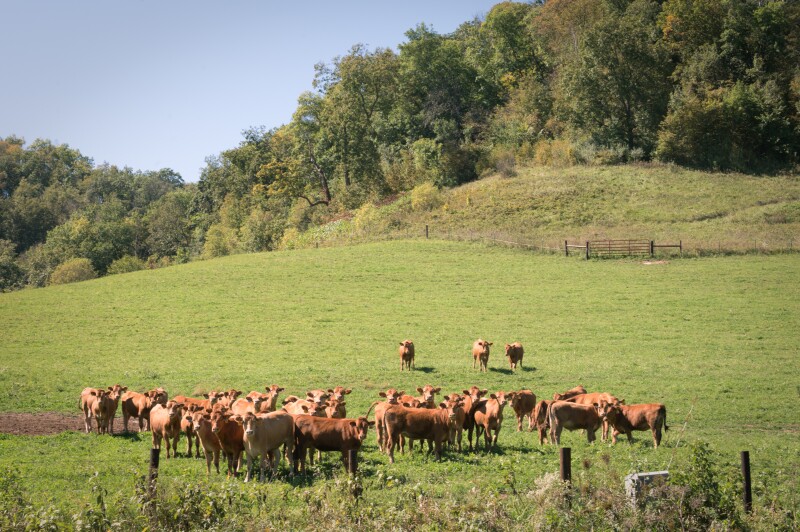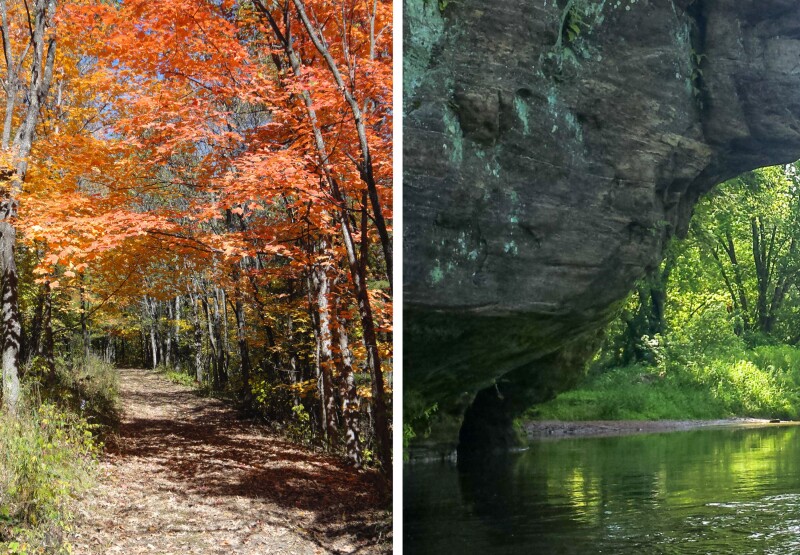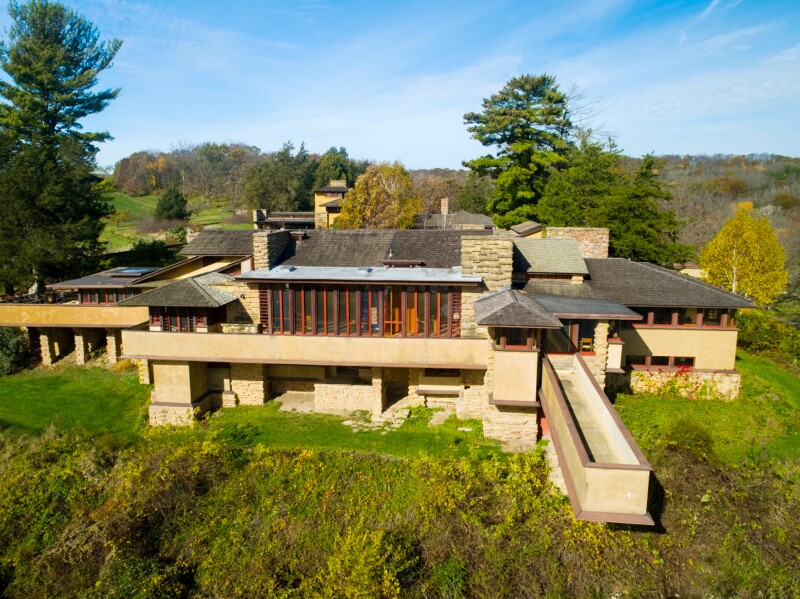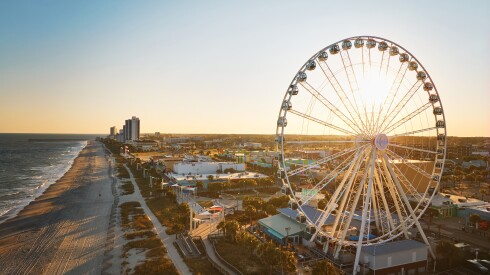On a crisp spring morning earlier this year, I climbed 500 feet up a series of quartzite boulders forming a natural staircase to a panoramic bluff at Devil’s Lake State Park, where I surveyed the unsung Midwest, a rugged outlier.
In their retreat after the last Ice Age, the glaciers of the upper Midwest scraped and ground down peaks and filled in crags, leveling the landscape most associated with Wisconsin, Minnesota, and Iowa. But more than 24,000 square miles where these states converge around the Mississippi was untouched by the ice sheets, leaving hills and dales to roll freely, secreting forest-banked rivers and sandstone sentinels.
This is known as the Driftless Area, and most of it resides in southwestern Wisconsin, a rural region that begins approximately 120 miles west of Milwaukee, where handmade signs advertise direct-from-the-farm eggs and winding roads link small towns and nature preserves.
Some of those farm stands, such as FarmerSown Market near tiny Viola, are run by members of Organic Valley, the farmer-owned coop established in 1988 by dairies here that wanted to maintain their small, family-sustaining, chemical-free ways and went on to become one of the nation’s leading producers of organic dairy.
In addition to nurturing sustainable growers, the Driftless, as it’s known locally, offers a bounty of only-in-Wisconsin experiences. It inspired the architecture of Frank Lloyd Wright, who spent boyhood summers in the area. It preserved evidence of 10,000-year-old cultures that migrated through in search of abundant game, and the land still supports healthy trout populations. This confluence of natural, cultural, and culinary attractions drew me to Wisconsin’s Driftless.

The town of Viroqua, situated among rolling green hills, offers a great base from which to explore the region.
Linda Horton/Shutterstock
Based in the bohemian town of Viroqua, 175 miles west of Milwaukee, I checked into the newly restored 1899 Hotel Fortney with 14 updated rooms and a lively ground-floor pub. My aim was to gauge the region’s life-in-the-slow-lane appeal, road-tripping between Baraboo in the east, La Crosse in the west, and Mineral Point in the south.
Natural meets human history
Free of scouring ice and glacial deposits, Driftless rivers carved the landscape through soft bedrock, creating steep banks with limestone and sandstone cliffs and caves. “If you were looking for a nice, sheltered place to stay over the winter, this is it,” says Amy Rosebrough, the state archaeologist at the Wisconsin Historical Society.
She explained that thousands of years ago, Indigenous people were making stone tools here and harvesting freshwater mussels in such abundance that they left behind heaps of shells a quarter-mile long. Hunters would have preyed upon elk, deer, and waterfowl. Rock art around the Kickapoo Valley Reserve, a Driftless conservation area surrounding the Kickapoo River, suggests it was a sacred area for hunters’ vision quests or women’s petitions for children. The visitor center offers an overview of the rock art; the park managers don’t disclose the rock-art locations because the works are prone to erosion, but a web of hiking trails in the park introduces the stone overhangs and river bends that might once have provided refuge.

Head to Kickapoo Valley Reserve for stunning foliage and calm waters for kayaking or fishing.
Photo courtesy of Kickapoo Valley Reserve
Landscapes for outdoor lovers
Cultivated by farms, the Driftless nonetheless harbors wilds ripe for adventure. The Kickapoo River is one of many cold-water streams that draw anglers here in search of trout. Paddlers, too, come for the abundant waterways, taking canoes and kayaks—rentals are widely available—past the Kickapoo’s sandstone cliffs or beaching them on the sandbars of the Wisconsin River, terminus of the 125-mile Kickapoo.
Hiking routes blend natural history and nature. That trek at Devil’s Lake State Park, about an hour’s drive north of Madison, reached Devil’s Doorway, a natural portal of stacked rock. At 500 feet, it overlooks what the ancestral Ho-Chunk people call Tee Wakącąk, or Sacred Lake, and the park is filled, like much of the region, with effigy burial mounds. (Many were historically plowed over by settlers, but Effigy Mounds National Monument across the Mississippi, in Iowa’s Driftless, preserves more than 200.)
Bluffs flanking the Mississippi give the mighty river a grand salute as it leaves the upper Midwest. On another morning, I hiked Sugar Creek Bluff, overlooking the Mississippi in Ferryville, to the soundtrack of whistling red-winged blackbirds and the percussive tapping of red-bellied woodpeckers.

Architect Frank Lloyd Wright lived in his Taliesin home in Wisconsin for almost 50 years.
Courtesy of Taliesin Visitor Center
Organic, from design to food
An influential landscape, the Driftless was key in nurturing architect Frank Lloyd Wright’s love of nature. Growing up in Madison, he often worked on his uncle’s farm in the Wisconsin River Valley, where he eventually built his home Taliesin.
“He was a keen observer of nature in the Driftless landscape from a very young age,” says Caroline Hamblen, director of programs at Taliesin. “When you drive through the Driftless region, you see the oak savannahs and rock outcroppings of sandstone and limestone. At Taliesin, the exact same landscape starts to become buildings.”
Back in Viroqua, I get the last seat at the bar at the Driftless Café, a bustling farm-to-table restaurant run by chef Luke Zahm. The chef grew up in the region, cooked in Madison, and came back about a dozen years ago for the outdoors—“I needed access to wild places where I could wander and get lost,” he says—as well as the food producers.
The menu, which changes daily to accommodate deliveries from more than 200 organic farms, listed beet arancini and harissa lamb chops, each dish preceded by the names of the farms that produced the ingredients.
“What we wanted to do with this restaurant is not celebrate a chef but, quite frankly, celebrate the farmers and food producers that make our restaurant possible,” says Zahm.
He attributes the farmers’ success to “intentional inefficiency,” a system based on community dedication. “It’s more efficient to grow in giant 2,000-acre plots,” he explains, noting that the success of small farmers banding together has attracted “people who want to embrace a more holistic, sustainable lifestyle.”
Bumper stickers call it “Driftless Slow.” It’s a pace, a perspective, and—for visitors—a slow-travel prize.
Need to know
Traveling around the Driftless Area requires a car. There are several unique hotels in the area, including the historic Hotel Fortney in Viroqua and the six-suite Tobacco Warehouse Inn in nearby Soldiers Grove, in a restored crop warehouse. Ridge & Valley Tours offers farm tours in the area by off-road vehicle.











